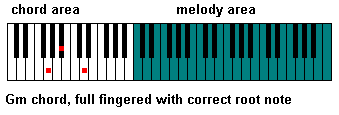
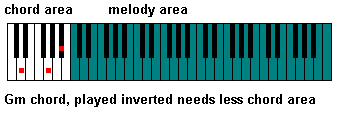
Chord recognition.
There are 7 chord recognition methods available: full fingered, single finger (Yamaha), single finger (Roland), fingered on bass, full keyboard, guitar and free form. They can be selected in the menu settings>chord fingering.


Default is full fingered. In full fingered mode you play all the keys of the chord. Chords can be played inverted, e.g play a G chords as D-G-B with D being the lowest key. But for some complex chords this may lead to different possibilities and in that case the not inverted chord always preceeds the inverted ones. Type 7 chords can be played with 3 keys, e.g. instead of C-E-G-A# you can play C-E-A# for a C7.
By default the lowest 24 keys on a 61 keys keyboard are reserved for playing chords. You may want a smaller chord area and a larger melody area. This can be done in the menu settings/keyboard control. The numbering of the keys in OMB may not be the same as the way they are numbered on your keyboard. The lowest key is called C3 in OMB but is often named C1 on keyboards. Use the View Midi In option in the keyboard control window to find out what the OMB name for the keys is.
Similar to full fingered is free form. The main difference is that you are not limited to existing chords. Any combination of 3 or 4 keys will be used to play the accompaniment. All bass notes will be played with the root note, defined by the lowest key. Therefore if you play existing chords in free form mode, then you must play them not inverted. E.g play an G chord as G-B-D not D-G-B.
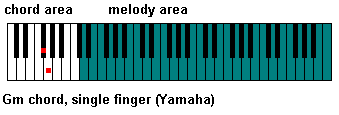
In single finger (Yamaha) mode you can play any major chord by just pressing the key in the chord area with the same name. Adding a black key on the left of this key will make it a minor chord and an extra white key on the left will make it a 7th chord. If you just began learning to play keyboard I would strongly advise against choosing this mode. It might seem the easiest way, but if you learn to play the basic major and minor chords with three fingers then you will also be able to play your music on keyboards without auto accompaniment (like a piano).
Single finger (Roland) mode is the same as Yamaha for major chords but the extra keys to form minor and other chordtypes are different. If you are a Roland or Korg player you will be familiar with this type of chord fingering.
Fingered on bass can use a bass note that is different from the root note of the chord. In songbooks this is presented as a slash chord. E.g C/E indicates a C chord with an E bass note. If you press a (full fingered) chord in fingered on bass mode then the lowest key will be the bass note. So pressing C-E-G will give a C chord, E-G-C will give a C/E and G-C-E will give a C/G.
It is not possible to produce a bass note that is not included in the chord keys in a static chord. But is possible to produce all bassnotes in a bass run. In a bass run the bass tone is lowered step by step starting from the chord root. To play a bass run you first press the chord not inverted. Wait for at least 0.5 seconds and then (without releasing the original chord keys) press another key on the left of the chord. The new key will be the bass tone and this way you can use your little finger to play the bass run.
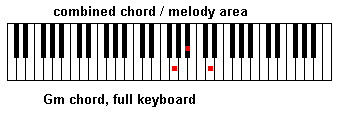
In full keyboard mode there is no separate chord and melody area on the keyboard. Whenever you have 3 or more keys pressed then the program will try to detect a chord. If there is an interval of more then 5 semitones between two keys then all the keys to the right will be regarded as melody notes and not be included in the chord. All chord types can be played. Functions assigned to keys will be ignored in this mode. You can activate the pedal is chord fixation option in menu settings. While this option is active no chord change will occur while the sustain pedal is pressed. This gives you more control on the chords that are chosen. The chord fixation action can be assigned to a different controller in menu settings/keyboard-control and the option can also be switched on and off with an assignable key function in window PC Keyboard 2 and MIDI Keyboard.
Roland GI 20 Guitar/MIDI-interface
Guitar mode is mainly intended for MIDI-guitar players but you can also use this to play keyboard. There is no distinction between chord area and melody area. Any note that is played will be regarded as both a chord and a melody note. In this mode only basic major and minor chords are recognised. Because all notes are regarded as chord and melody notes, you can't use notes to switch variations. Use either the PC keyboard for that or use pedals that produce controller or patch( voice) messages. Do not set the string sensitivity of your MIDI device to high, you may already trigger a Note On when you place your lefthand finger on the fret and produce unwanted inbetween chords.
If you use this mode with a keyboard then you should make some adjustments to your playing style to prevent that melody notes lead to unintended chords. If you press a chord that is recognised then (while you keep it pressed) it will not change when extra notes are pressed (for the melody). If you release the chord keys to make rhythmic moves, then try to avoid pressing more then two keys at a time until the chord keys are pressed again.
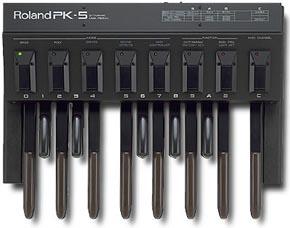
To play chords with a set of MIDI bass pedals choose single fingered (Yamaha) mode and assign the "minor pedal" in the menu settings/keyboard-control window to the highest C key of the MIDI pedals. Program your MIDI pedals to send notes below the range of your keyboard. Assign the chord area to the range of the MIDI pedals, use the "view midi in option" to check that the keys correspond with the specified notes. In stead of using the high C of the MIDI pedals you can also assign the minor key to a sustain pedal or something else. When you press a bass pedal then a major chord will be activated. But if you press the minor pedal then the text "MINOR" will appear in the chord display. This means that the next bass pedal pressed will be a minor chord. You will have to repeat the minor pedal before each chord. If you pressed it unintendedly then you can press it again to correct it.
In MIDI accordions the chord buttons produce full fingered chord notes on a channel different from the channel used by the melody keys. Define this "Chord channel" in the keyboard controlwindow and there will be no problem with an overlapping chord and melody area.
In full fingered mode the C chord types are:
| C | C E G |
| C6 | C E G A |
| CMaj7 | C E G B |
| CMaj7(#11) | C E F# B |
| Cadd(9) | C E G D |
| CMaj7(9) | C E D B |
| C6(9) | C E D A |
| Caug | C E G# |
| Cm | C Eb G |
| Cm6 | C Eb G A |
| Cm7 | C Eb (G) Bb |
| Cm7b5 | C Eb F# Bb |
| Cmadd(9) | C Eb G D |
| Cm7(9) | C Eb D Bb |
| Cm7(11) | C Eb F Bb |
| CmMaj7 | C Eb G B |
| CmMaj7(9) | C Eb D B |
| Cdim | C Eb F# |
| Cdim7 | C Eb F# A |
| C7 | C E (G) Bb |
| C7sus4 | C F G Bb |
| C7b5 | C E F# Bb |
| C7(9) | C E D Bb |
| C7(#11) | C E F# Bb |
| C7(13) | C E A Bb |
| C7(b9) | C E C# Bb |
| C7(b13) | C E G# Bb |
| C7(#9) | C E Eb Bb |
| CMaj7aug | C E G# B |
| C7aug | C E G# Bb |
| Csus4 | C F G |
| C1+2+5 | C D G |
Back to the One Man Band main page.